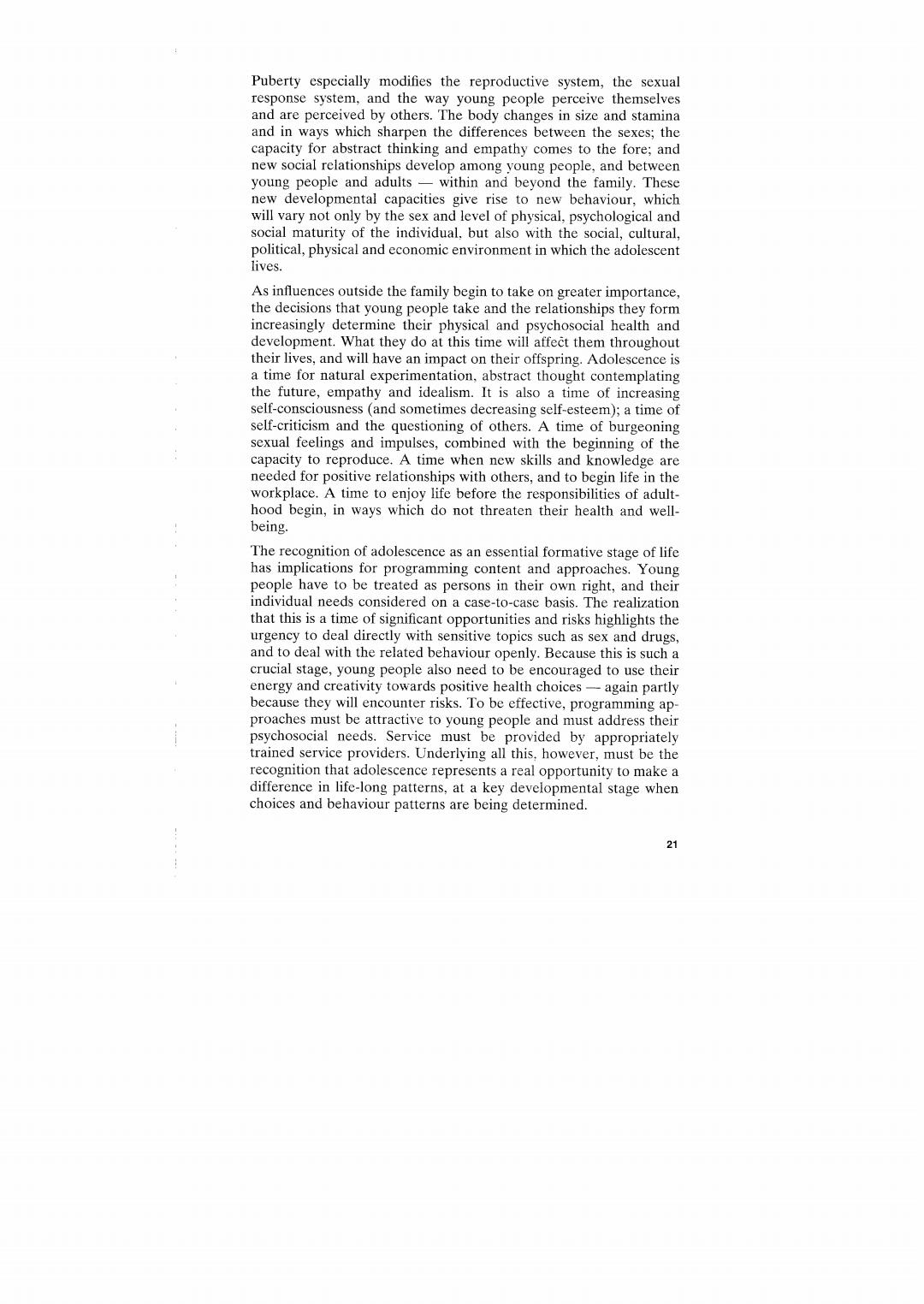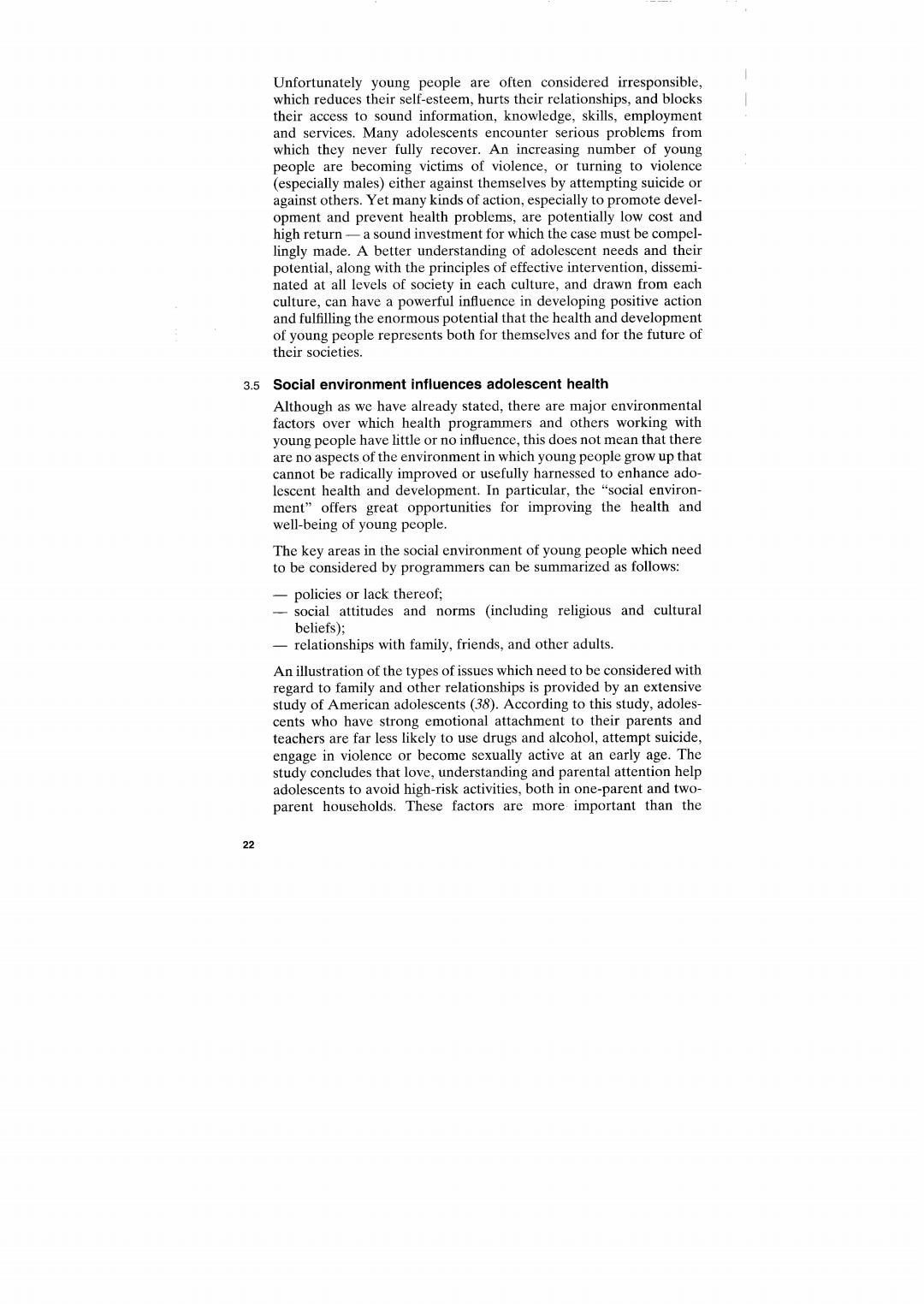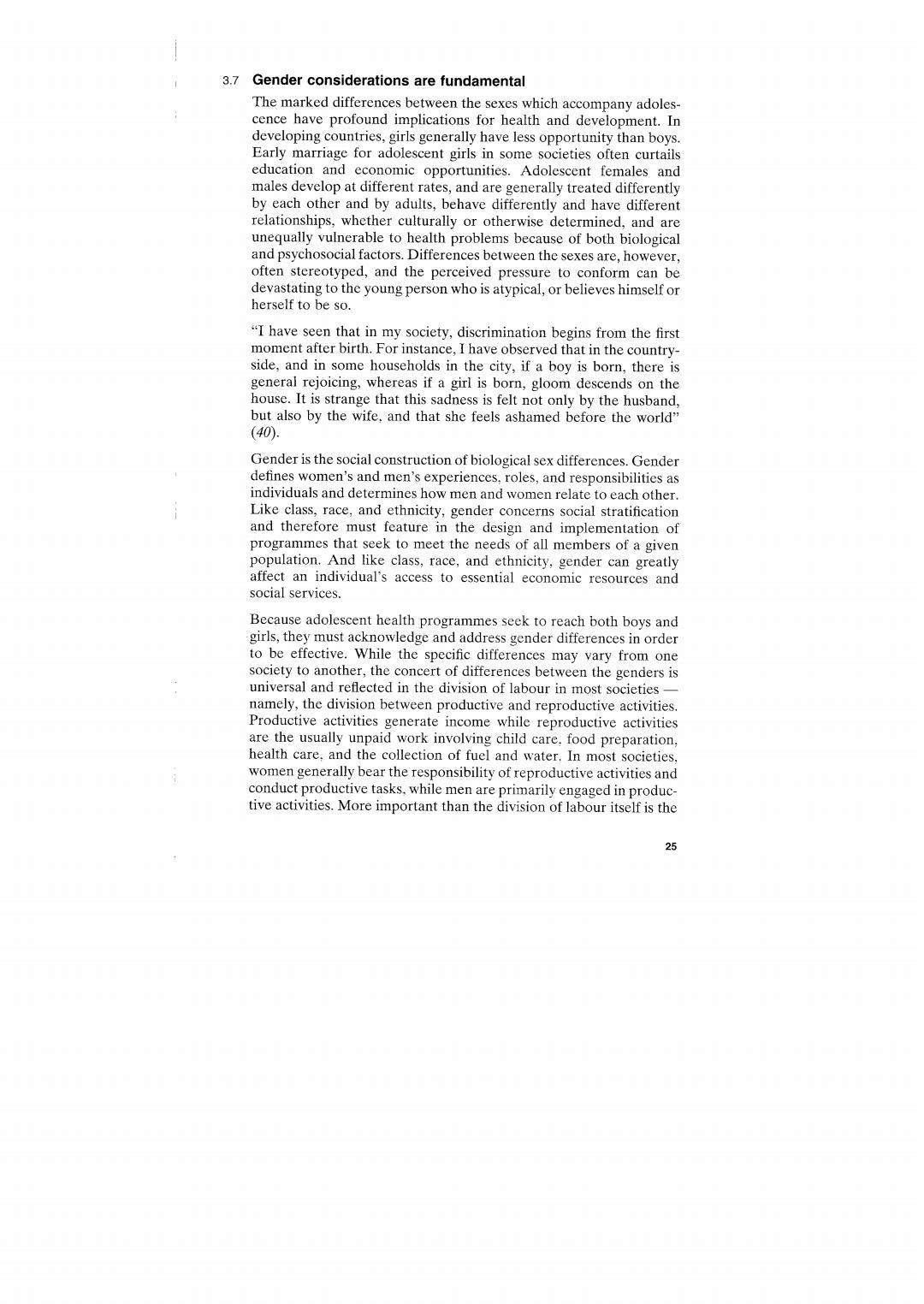
Puberty especially modifies the reproductive system,the sexual response system,and the way young people perceive themselves and are perceived by others.The body changes in size and stamina and in ways which sharpen the differences between the sexes;the capacity for abstract thinking and empathy comes to the fore;and new social relationships develop among young people,and between young people and adults -within and beyond the family.These new developmental capacities give rise to new behaviour,which will vary not only by the sex and level of physical,psychological and social maturity of the individual,but also with the social,cultural. political,physical and economic environment in which the adolescent lives. As influences outside the family begin to take on greater importance, the decisions that young people take and the relationships they form increasingly determine their physical and psychosocial health and development.What they do at this time will affect them throughout their lives,and will have an impact on their offspring.Adolescence is a time for natural experimentation,abstract thought contemplating the future,empathy and idealism.It is also a time of increasing self-consciousness (and sometimes decreasing self-esteem);a time of self-criticism and the questioning of others.A time of burgeoning sexual feelings and impulses,combined with the beginning of the capacity to reproduce.A time when new skills and knowledge are needed for positive relationships with others,and to begin life in the workplace.A time to enjoy life before the responsibilities of adult- hood begin,in ways which do not threaten their health and well- being. The recognition of adolescence as an essential formative stage of life has implications for programming content and approaches.Young people have to be treated as persons in their own right,and their individual needs considered on a case-to-case basis.The realization that this is a time of significant opportunities and risks highlights the urgency to deal directly with sensitive topics such as sex and drugs and to deal with the related behaviour openly.Because this is such a crucial stage,young people also need to be encouraged to use their energy and creativity towards positive health choices-again partly because they will encounter risks.To be effective,programming ap- proaches must be attractive to young people and must address their psychosocial needs.Service must be provided by appropriately trained service providers.Underlying all this,however,must be the recognition that adolescence represents a real opportunity to make a difference in life-long patterns,at a key developmental stage when choices and behaviour patterns are being determined. 21

Unfortunately young people are often considered irresponsible, which reduces their self-esteem,hurts their relationships,and blocks their access to sound information,knowledge,skills,employment and services.Many adolescents encounter serious problems from which they never fully recover.An increasing number of young people are becoming victims of violence,or turning to violence (especially males)either against themselves by attempting suicide or against others.Yet many kinds of action,especially to promote devel- opment and prevent health problems,are potentially low cost and high return-a sound investment for which the case must be compel- lingly made.A better understanding of adolescent needs and their potential,along with the principles of effective intervention,dissemi- nated at all levels of society in each culture,and drawn from each culture,can have a powerful influence in developing positive action and fulfilling the enormous potential that the health and development of young people represents both for themselves and for the future of their societies. 3.5 Social environment influences adolescent health Although as we have already stated,there are major environmental factors over which health programmers and others working with young people have little or no influence,this does not mean that there are no aspects of the environment in which young people grow up that cannot be radically improved or usefully harnessed to enhance ado- lescent health and development.In particular,the "social environ- ment"offers great opportunities for improving the health and well-being of young people. The key areas in the social environment of young people which need to be considered by programmers can be summarized as follows: policies or lack thereof: social attitudes and norms (including religious and cultural beliefs); -relationships with family,friends,and other adults. An illustration of the types of issues which need to be considered with regard to family and other relationships is provided by an extensive study of American adolescents (38).According to this study,adoles cents who have strong emotional attachment to their parents and teachers are far less likely to use drugs and alcohol,attempt suicide, engage in violence or become sexually active at an early age.The study concludes that love,understanding and parental attention help adolescents to avoid high-risk activities,both in one-parent and two- parent households.These factors are more important than the

amount of time parents spend with their children.At school,positive relationships with teachers were found to be more important in pro- tecting adolescents than any other factor,including classroom size or the amount of training a teacher has. Such findings confirm what other studies have shown-family rela tionships are critical in supporting healthy adolescent development. As the study has noted:"Many people think of adolescence as a stage where there is so much peer influence that parents become both irrelevant and powerless.It is not so that parents are not important. Parents are just as important to adolescents as they are to smaller children.” In its examination of schools,the study looked at attendance rates parent involvement,dropout rates,teacher training,whether schools were public or private and whether teenagers felt close to their teach- ers and if they perceived other students as prejudiced.But only one of those (whether students felt close to their teachers)made a difference in helping teenagers avoid unhealthy behaviour,confirming the overriding importance of the human interaction.Thus,the develop- ment and health of an adolescent is dependent not only upon the individual,but also upon the social environment that informs the decision-making process.The overall aim of adolescent programmes must be to produce well-informed,skilled young people who are motivated to make healthy choices,through an environment that encourages and facilitates these choices,and provides key services opportunities,and interpersonal support. 3.6 Not all young people are equally vulnerable While certain characteristics and developmental needs are peculiar to all adolescents,some groups within the adolescent population have specific needs and/or vulnerability.In order to provide equitable op- portunities and services to adolescents,there is need to make focused efforts to reach the very vulnerable and disadvantaged to ensure that their problems are understood and their needs met.The differences within adolescent population groups may be due to environmental factors and/or individual characteristics. The environmental factors that make adolescents vulnerable or place them at special disadvantage are partly attributable to unsuccessful or inequitable development processes,or processes disrupted by war or by major pandemics (such as HIV/AIDS).Some of the underlying causes include the social impact of economic crises and the destabili- zation of social structures. For the purposes of assessment and consequent design of appropriate interventions,it may be necessary to categorize the circumstances in 23

which some adolescents live,even though this can lead to the highly negative labelling of some young people.These circumstances in- clude: -temporary or permanent loss of family and/or primary caregivers; -sexual abuse or exploitation; disability; -warfare and other emergencies; addiction: extreme poverty,especially when this leads to work in hazardous situations. In terms of operation,programming for adolescent health and development focuses on the needs of all young people by maintaining and strengthening their development,and enhancing prevention. Special efforts,however,may be necessary to reach vulnerable adolescents. Thus,specific preventive strategies are needed to protect some ado- lescents from further marginalization,as exemplified by the 35000 schools run by the BRAC programme in Bangladesh to provide basic education to very poor children who might otherwise be left out of the school system altogether-especially adolescent girls.For adoles- cents already in very difficult circumstances such as war,compensa- tory strategies will be needed to help them cope with the damage suffered.However,for adolescents who have suffered other trauma, such as sexual abuse and addiction,rehabilitation will be necessary.It should include appropriate institutional and alternative care arrange- ments (foster families for children orphaned by warfare and AlDS. community-based rehabilitation for adolescents with disabilities). These adolescents,like their less vulnerable peers,still require sup- port for their basic health and development needs. However,as one recommendation based on experience with demobi- lized child soldiers in Mozambique states: "the special needs of potentially vulnerable groups,including youth, women and the disabled,should be carefully considered.The under- lying objective of targeted programmes should be to include these groups in mainstream activities where possible"(39). In other to deliver programmes which address the needs of all young people,careful assessment is needed to better understand the full range of adolescent needs and situations in their country or local area -a subject dealt with more fully in section 8.The types of interven- tion,particular settings,and approaches to be used will differ for diverse types of adolescent population

3.7 Gender considerations are fundamental The marked differences between the sexes which accompany adoles- cence have profound implications for health and development.In developing countries,girls generally have less opportunity than boys Early marriage for adolescent girls in some societies often curtails education and economic opportunities.Adolescent females and males develop at different rates,and are generally treated differently by each other and by adults,behave differently and have different relationships,whether culturally or otherwise determined,and are unequally vulnerable to health problems because of both biological and psychosocial factors.Differences between the sexes are,however, often stereotyped,and the perceived pressure to conform can be devastating to the young person who is atypical,or believes himself or herself to be so. "I have seen that in my society,discrimination begins from the first moment after birth.For instance,I have observed that in the country- side,and in some households in the city,if a boy is born,there is general rejoicing,whereas if a girl is born,gloom descends on the house.It is strange that this sadness is felt not only by the husband, but also by the wife,and that she feels ashamed before the world" (40). Gender is the social construction of biological sex differences.Gender defines women's and men's experiences,roles,and responsibilities as individuals and determines how men and women relate to each other. Like class,race,and ethnicity,gender concerns social stratification and therefore must feature in the design and implementation of programmes that seek to meet the needs of all members of a given population.And like class,race,and ethnicity,gender can greatly affect an individual's access to essential economic resources and social services. Because adolescent health programmes seek to reach both boys and girls,they must acknowledge and address gender differences in order to be effective.While the specific differences may vary from one society to another,the concert of differences between the genders is universal and reflected in the division of labour in most societies- namely,the division between productive and reproductive activities. Productive activities generate income while reproductive activities are the usually unpaid work involving child care,food preparation, health care,and the collection of fuel and water.In most societies, women generally bear the responsibility of reproductive activities and conduct productive tasks,while men are primarily engaged in produc- tive activities.More important than the division of labour itself is the 25